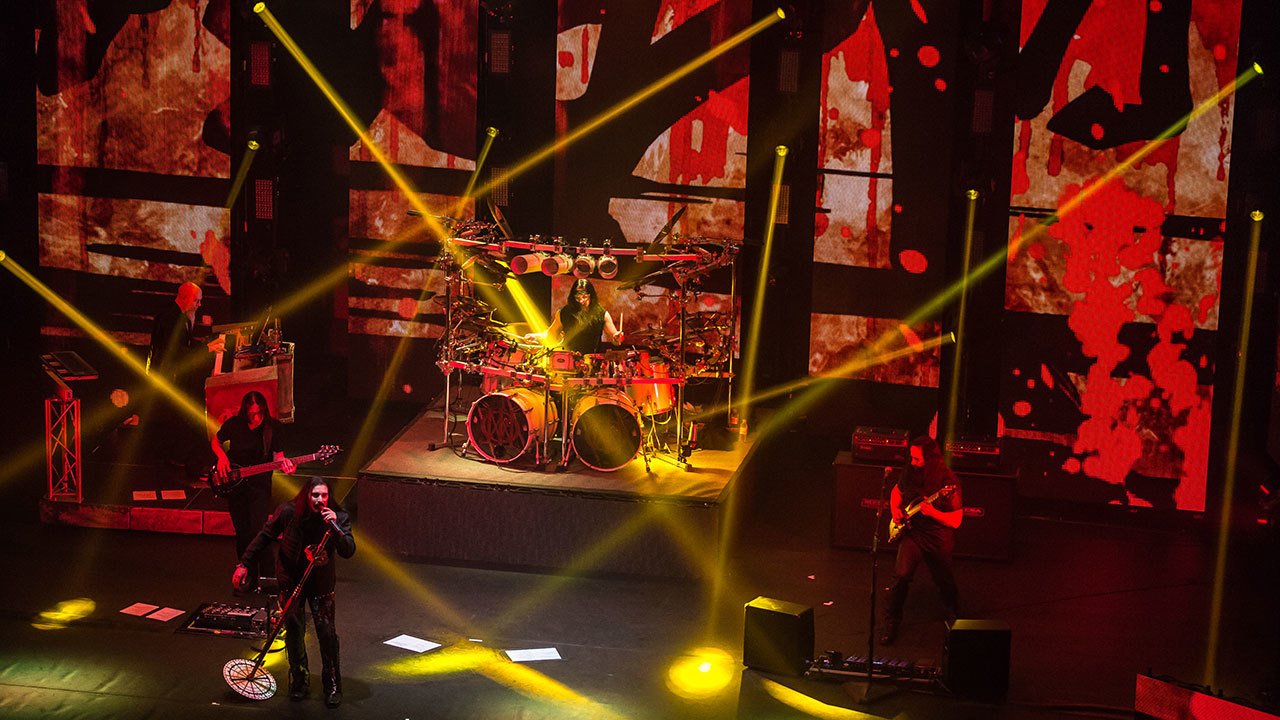It’s fair to say that Dream Theater’s The Astonishing tour has lived up to the billing. Raising the bar far beyond the industry-standard pyro and ego ramps, February’s premiere saw the London Palladium transform into an immersive, sensory-tickling world of sound and vision. For the latter, all credit to Bernard Duguay, founder of Montreal visual production firm Lucion, and co-creator of the eye-popping animated films that run alongside the US prog-rockers’ performance. “It had to be,” Duguay tells us, “like an added amphetamine…”
How did you come to work with Dream Theater?
“It was an accident. I was posting on the Facebook page of the band Project RnL, commenting on a song that Jordan Rudess [DT keys player] had played with them. Then Jordan answered me back and asked what I did. I said, ‘I’m a visual artist, and we do installations and staging design’. He asked me to send him some stuff. Eventually, after maybe a year of emailing and Facebook, he said, ‘Would you like to do a show with us?’ I fell off my chair.”
How did The Astonishing project develop from there?
“Well, I talked with the band on a huge conference call. We met a few times via Skype. John Petrucci sent the scenario – 20 pages of this dark fantasy, mixing the future and the past – then we did a brainstorm and storyboards. That went well, and we got deeper into details, and started production. We had 3D animators, 2D animators, modellers: we were 29 people at one point. But we got the music a little late – and that blew everything up in the air.”
When you heard The Astonishing album, what images came into your head?
“Well, it was grandiose, much more intense than I anticipated. Rock can be powerful – but this was more like an opera. Sometimes, there were four genres in the same song. So that really made us raise the bar. You had to feel the torment and the ecstasy, visually. It had to convey a lot of story, who was going to win, who was going to die. It had to have guts, y’know?”
Your films are pretty trippy – was any LSD involved in their creation?
“Hah – maybe! The music was the most pertinent drug. That was really the fuel that made us go crazy on this. Because it had to fly. It had to be dark. It had to be terrible. I think the darkest scene is in The Path That Divides, where Arhys is murdered. I love the dark stuff in their music.”
Did the band approve everything you gave them?
“There was one song – A New Beginning – that was weak. We just didn’t have time to really finish it. I knew they wouldn’t like that one. But we took time after the premiere to go back and finish that. But generally, they told us to trust our own creativity, more than the storyboard. [The visuals] had to be like an added amphetamine.”
Anything you weren’t allowed to do?
“Yes, absolutely. There was supposed to be a holographic screen on the stage, so there could be a dialogue between the characters in the movie and the musicians onstage. That was the next step. But [we couldn’t do it] because of time – it would have caused a lot more rehearsals.”
- Tesseract to support Devin Townsend Project on UK tour
- Opinion: British metal has a massive problem – and here’s why
- Every Meshuggah album ranked from worst to best
- The 10 Sexiest Prog Songs... Ever
What was your reaction when you saw the show?
“I cried. I’m still flabbergasted at how well it all came together. My favourite visual moment is when you get into Ravenskill. The crowd just lifts, because it’s very industrial, y’know, fire and metal. And you can tell the crowd loves that dark, metallic stuff, much more than some futuristic, plasticky city. But The Road To Revolution is my preferred song, because it’s very dreamy, and it has metaphors of who the characters are and what they represent.”
So what’s next for Lucion – fancy working with another band?
“Yeah – but I love a lot of bands who don’t have much money! I mean, the door is open, for sure. We’d love to work with more bands. I wrote to Yes. Peter Gabriel would be great. The concept bands, y’know?”
Visually speaking, what are your favourite rock shows of all time?
“I love Gorillaz’s visuals. Of course, Pink Floyd’s Wall and all the animation in that. You really get into the story with them. I saw them in Montreal, and the actual video mapping on the wall itself was quite a feat. I think the future of rock is that it will become installations. Of course, it’s a show, but the idea would be to get inside, as if the music was architecture. So you could visit The Wall, you could visit The Dark Side Of The Moon. So they might become more physical, all these concepts.”
Would you like to work with Dream Theater again?
“If they want to come back – anytime.”
For more information on Lucion’s work, see www.lucionmedia.ca/en
Dream Theater go behind the scenes of The Astonishing stage show
Dream Theater writing partners reached creative peak on The Astonishing

